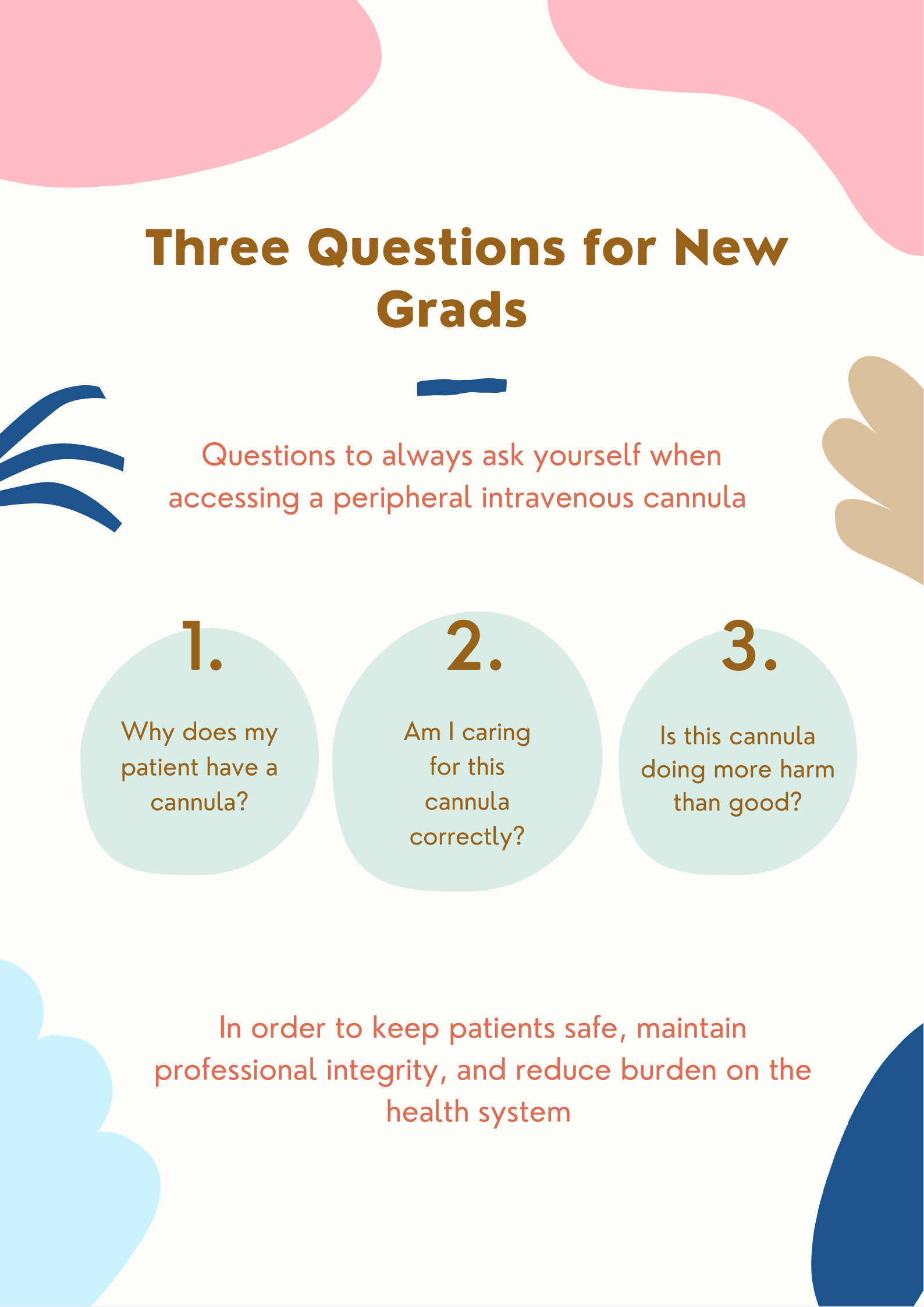PIVC Essentials: Three Tips for New Grads
)
"Hi, I'm Lizzy, and I'm in my final semester of a dual bachelors of nursing and midwifery, and am fortunate to be undertaking a Winter Research program with the AVATAR group. I have decided to focus on tips for a new grad as my first topic as I am going to be a grad at the start of next year, and I believe that a lot of benefit can be gained from easy access to summarised, accurate information."
Coming into the hospital setting as a graduate nurse, or 'grad' can be daunting. As a grad, you need to focus on the significant changes that come with the transition from student to registered nurse, but remembering the fundamentals of nursing is crucial.
Below are three questions you should ask yourself when caring for a patient with a peripheral intravenous cannula (PIVC), with three things to consider for each question and a tip for helping you decide what to do next.
Always remember to follow your local hospital policy and scope of practice, and be aware of any changes between clinical areas.
Question One: Why does my patient have a cannula?
1. Check the patient's chart for current intravenous orders. There should be a valid fluid or medication order and indication for IV over oral route. 'Just in case' is not a valid reason for a PIVC.
2. Assess if the patient is able to eat and drink. A PIVC may no longer be required if a patient has adequate oral fluid intake.
3. If you're not sure, ask the patient when the cannula was last used. If it was longer than 24 hours, it should probably come out.
Tip: if you think the PIVC no longer needs to be in situ, ask your team leader if you can remove it. Once you gain confidence, you'll be able to make this decision for yourself.
Question Two: Am I caring for this cannula correctly?
1. Clean the PIVC access port for 15 seconds using a sterile, single-use alcohol wipe and allow to air dry before accessing.
2. Flush the PIVC before and after medication administration in a pulsating motion using a sterile, single-use syringe at least 10mL capacity
3. Check the transparent, semi-permeable dressing is clean, dry and intact, and examine the PIVC insertion site for signs of irritation or inflammation every time it's accessed. And don't forget to ask the patient if they have any concerns with the cannula.
Tip: take the time to care for the PIVC properly and you'll decrease the patient's risk of complications, including bloodstream infections.
Question Three: Is this cannula doing more harm than good?
1. If the patient will need IV fluids or medications for more than five days, a central line may be preferable.
2. If the PIVC location is in an area of flexion (wrist or anti cubital fossa), the patient may not be able to fulfil ADLs, which can have further consequences.
3. If the cannula is not in use, was inserted in another facility, during an emergency it should be removed within 24 hours.
Tip: Remember that every PIVC is an infection risk and should be removed in a timely manner!
References:
Australian Commission on Safety and Quality in Health Care. (2021). Management of Peripheral Intravenous Catheters: Clinical Care Standard. Sydney: ACSQHC, 76(12).
Massey, D., Craswell, A., Ray-Barruel, G., Ullman, A., Marsh, N., Wallis, M., & Cooke, M. (2020). Undergraduate nursing students' perceptions of the current content and pedagogical approaches used in PIVC education. A qualitative, descriptive. Nurse Education Today. 94
Queensland Health. (2019). Recommendations for the prevention of infection in intra-vascular devices. Brisbane: Queensland Health.
Ray-Barruel, G., Cooke, M., Chopra, V., Mitchell, M., & Rickard, C. M. (2020). The I-DECIDED clinical decision-making tool for peripheral intravenous catheter assessment and safe removal: a clinimetric evaluation. BMJ Open, 10(1), e035239
Slated, K., Cooke, M. Fullerton, F., Whitby, M., Hay, J., Lingard, S., Whitby, M., Hay, J., . . . Rickard, C. (2019). Peripheral Intravenous catheter needleless connector decontamination study Randomised controlled trial. American Journal of Infection Control. 48 (9), 1013, 1018.
| Tags:peripheral intravenous cathetercannulaIV managementevidence-based practice |








